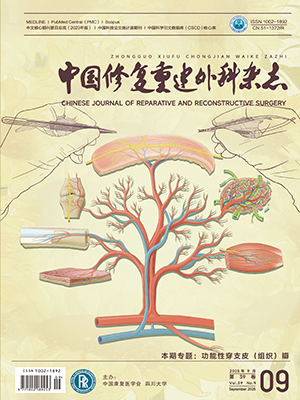Objective To observe the plastic changes of sensory nerve in terms of structure and function when target
organ changed through making the rat model of nerve regeneration by anastomosing the proximal end of sensory nerve and the distal end of motor nerve. Methods Thirty adult SD rats (male or female), weighing 200-250 g, were randomized into three groups (n=10 per group). The left upper l imb of the each rat was used as the experimental side, while the right upper l imb as the control side. In group A, the medial antebrachial cutaneous nerve was cut 5 mm away from its origin and its proximal end was anastomozed end-to-end to the distal end of musculocutaneous nerve. In group B, the musculocutaneous nerve was cut 5 mm away from its nerve entry point and the proximal end of medial antebrachial cutaneous nerve were anastomozed end-to-end to the distal end of musculocutaneous nerve. In group C, medial antebrachial cutaneous nerve and musculocutaneous nerve were cut, without further anastomosis. Twenty-four weeks after operation, the general condition and the motion of the elbow joint of rats, the wet weight and muscle fiber cross-section area of the biceps brachii as well as the latent period and the ampl itude of the evoked potential were observed and the acetylchol inesterase (AchE) staining of nerve of proximal end of anastomosis was conducted. Results All the rats survived for 24 weeks with good general condition and without wound infection. The rats in groups A, B and C were lost the active flexion of left elbow joint after operation. The rats in groups A and B got recovered to some degree at 24 weeks. The behavioral evaluation showed that there were 7 l imbs in group A and 5 l imbs in group B scored
as 4-5 points, there was a significant difference when compared with group C (P lt; 0.05), but there was no significant difference between group A and group B (P gt; 0.05). Group A and group B were superior to group C in terms of the wet weight and the muscle fiber cross-section area of the biceps brachii (P lt; 0.05), but no significant difference between group A and group B was detected (P gt; 0.05). The evoked potential of the biceps brachii and motor nerve fibers in proximal end of anastomosis could be detected in both group A and group B. But there was no significant difference between group A and group B with respects of function recovery of elbow joint, the latent period and the ampl itude of the evoked potential of the biceps brachii and the quantity of motor nerve fiber in proximal end of anastomosis (P gt; 0.05). Conclusion The change of target organ leads to the sensory nerve plasticity structurally and functionally, which may provide a new approach for peripheral nerve repair.
Citation: MA Nan,LU Laijin,MA Lihua,ZHANG Jingying,ZHANG Zhixin. EXPERIMENTAL STUDY ON PERIPHERAL NERVE PLASTICITY IN RATS. Chinese Journal of Reparative and Reconstructive Surgery, 2008, 22(9): 1073-1076. doi: Copy
Copyright © the editorial department of Chinese Journal of Reparative and Reconstructive Surgery of West China Medical Publisher. All rights reserved




